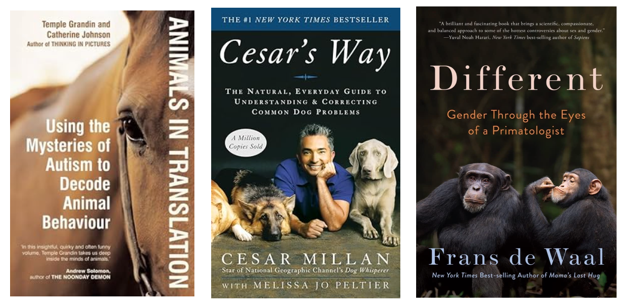I’m a dog owner. Dogs are animals. Humans are animals. What can we learn from our animal friends, and their approach to communication? There is an indigenous saying, “dogs make us human”.
Connected to my interests in human communications, I enjoy reading about people who have spent their lives working with animals. They were absorbed in the worlds of animal communications and relationships.
Three animal authors whom I’m hooked into are Temple Grandin, Cesar Millan, and Frans de Waal. Recommended books by them that I’ve read (and/or re-read) include:
Some of the common elements that I’ve discovered, and that bridge the species covered by those three animal experts, I feel can/should be adapted to our human species.
3 strategies for better communications and conflict management
Hyper-specificity. Animals are detailed oriented. Humans are generalists. Animals know exactly who they are dealing with. They experience reality, viscerally. They are attuned to difference. We humans have “inattentional blindness”, courtesy of our large brains. Our brains interpret everything. That person in front of us? We are quick to judge without knowing much about them. Through awareness of our own senses and emotions we can be more present, dial in, to their story and uniqueness. Its from that uniqueness that constructive conversations and relationships emerge.
Seek out and work with the raw data. Animals have privileged access to lower levels of raw information. Their senses are acute. Their sensory focus often differs from humans. For example, dogs first smell, then see, then hear. This is opposite to humans. Animals sense energy as we can only dream to. Their memories are extreme. Normal people see and hear schemas, not raw sensory data. The ability to problem-solve under novel conditions, e.g., wicked problems, requires raw data. That’s been my experience, whether as an IT consultant, mediator, or innovation facilitator. Explore as many solution options as possible, before murdering your darlings, and converging on the best.
Move away from mind-body dualism. The vast majority of communications is non-verbal. It’s also involuntary. The notion that our mind and body is separate is out of touch with everything we have learned from modern psychology and neuroscience. “The body, which includes the brain, is central to who we are and what we are. By running away from our bodies, we only run away from ourselves… Our conciliatory tendencies are shaped by biological evolution.” Emotional intelligence and neurobiological understanding flow from a sound mind-body awareness.
Biomimicry
We have much to learn from nature, and the animals we share this world with. Biomimicry is a practice that learns from and mimics the strategies used by living organisms to solve challenges comparable to the ones we face as individuals and societies. I sense we have only just begun this mimicry journey.


Speak Your Mind